Airport type Public, Defunct 13/31 3,390 Elevation 9 m | Serves Hong Kong Elevation AMSL 9 m / 30 ft 3,390 11,122 | |
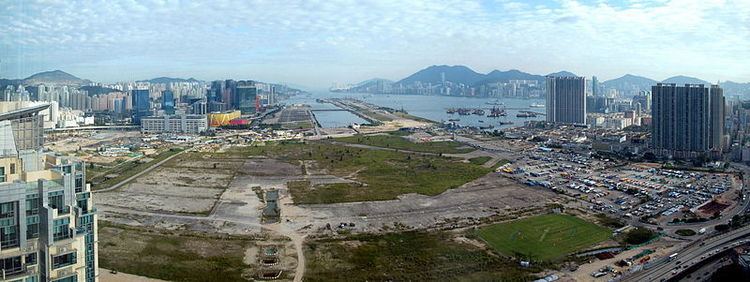 | ||
Kai tak airport history
Kai Tak Airport (IATA: HKG, ICAO: VHHH) was the international airport of Hong Kong from 1925 until 1998. It was officially known as Hong Kong International Airport from 1954 to 6 July 1998, when it was closed and replaced by the new Hong Kong International Airport at Chek Lap Kok, 30 kilometres (19 mi) to the west. It is often known as Hong Kong International Airport, Kai Tak, or simply Kai Tak, to distinguish it from its successor which is often referred to as Chek Lap Kok Airport.
Contents
- Kai tak airport history
- 747 cockpit landing hong kong kai tak airport 1998
- Geographic environment
- 1920s to 1930s
- World War II
- 1945 to 1970s
- Overcrowding in the 1980s and 1990s
- Closure and legacy of Kai Tak Airport
- Terminals and facilities
- Airlines based at Kai Tak
- Runway 13 approach
- Runway 13 departure
- Runway 31 approach
- Runway 31 departure
- Incidents and accidents
- 2002 blueprint
- Kai Tak Planning Review
- June 2006 blueprint
- October 2006 blueprint
- 2011 onwards
- References
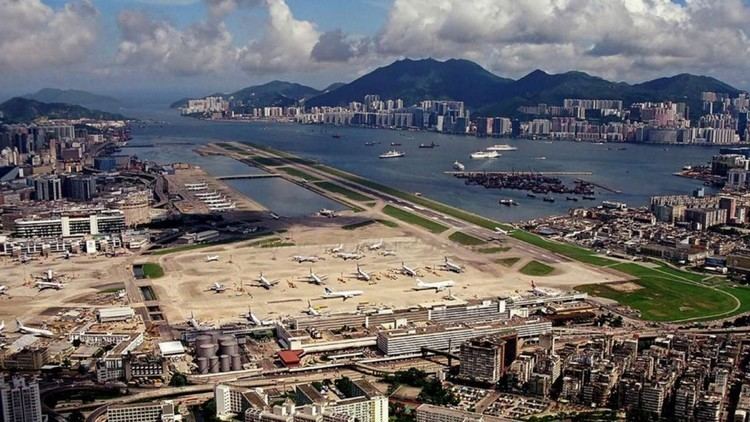
With numerous skyscrapers and mountains located to the north and its only runway jutting out into Victoria Harbour, landings at the airport were dramatic to experience and technically demanding for pilots. The History Channel program Most Extreme Airports ranked it as the 6th most dangerous airport in the world.
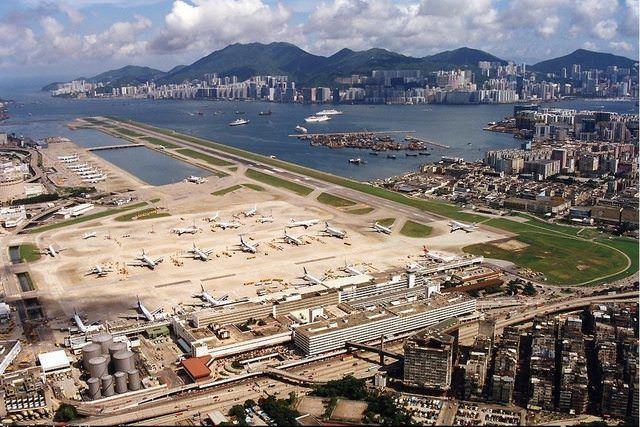
The airport was home to Hong Kong's international carrier Cathay Pacific, as well as regional carrier Dragonair, freight airline Air Hong Kong and Hong Kong Airways. The airport was also home to the former RAF Kai Tak.
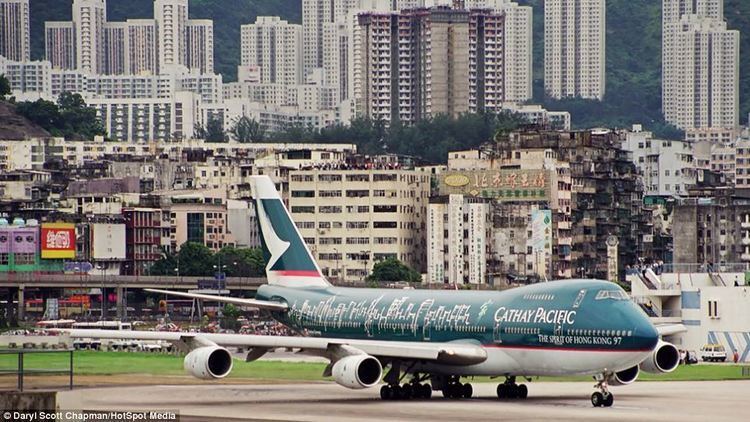
747 cockpit landing hong kong kai tak airport 1998
Geographic environment
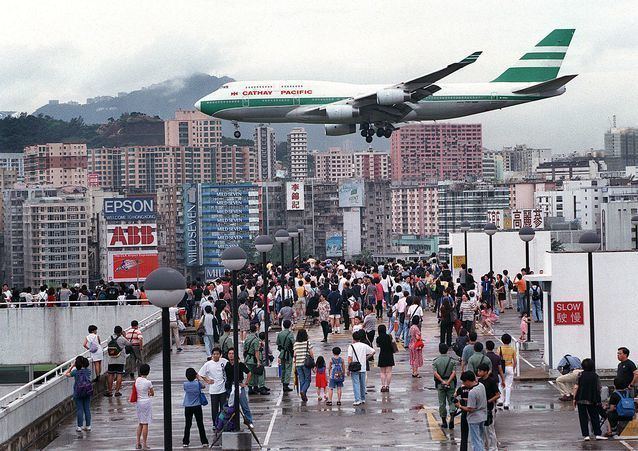
Kai Tak was located on the west side of Kowloon Bay in Kowloon, Hong Kong. The area is surrounded by rugged mountains. Less than 10 km (6.2 mi) to the north and northeast is a range of hills reaching an elevation of 2,000 ft (610 m). To the east of the runway, the hills are less than 5 km (3.1 mi) away. Immediately to the south of the airport is Victoria Harbour, and farther south is Hong Kong Island with hills up to 2,100 ft (640 m).
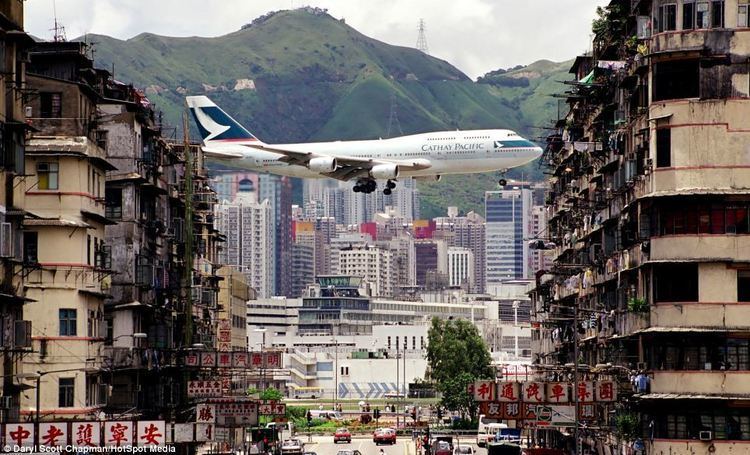
When Kai Tak closed, there was only one runway in use, numbered 13/31 and oriented southeast/northwest (134/314 degrees true, 136/316 degrees magnetic). The runway was made by reclaiming land from the harbour and was extended several times after its initial construction. The runway was 3,390 m (11,120 ft) long when the airport closed.
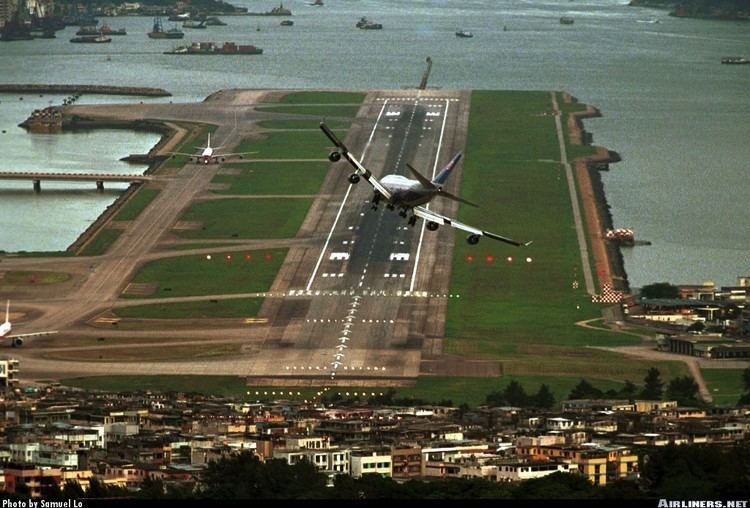
At the northern end of the runway, buildings rose up to six stories just across the road. The other three sides of the runway were surrounded by Victoria Harbour. The low-altitude manoeuvre required to line up with the runway was so spectacular that some passengers claimed to have seen television sets in the apartments: "...as the plane banked sharply to the right for landing ... the people watching television in the nearby apartments seemed an unsettling arms length away."
1920s to 1930s
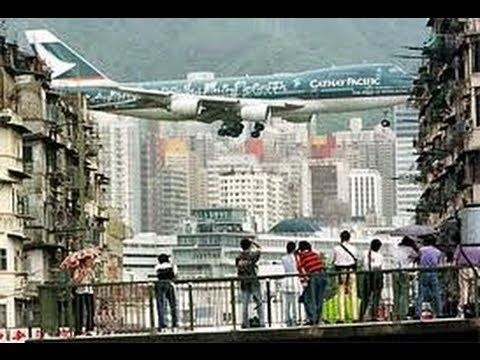
The story of Kai Tak started in 1912 when two businessmen Ho Kai and Au Tak formed the Kai Tak Investment Company to reclaim land in Kowloon for development. The land was acquired by the government for use as an airfield after the business plan failed.
In 1924, Harry Abbott opened The Abbott School of Aviation on that piece of land. Soon, it became a small grass strip runway airport for the RAF and several flying clubs which, over time, grew to include the Hong Kong Flying Club, the Far East Flying Training School, and the Aero Club of Hong Kong, which exist today as an amalgamation known as the Hong Kong Aviation Club. In 1928, a concrete slipway was built for seaplanes that used the adjoining Kowloon Bay. The first control tower and hangar at Kai Tak were built in 1935. In 1936, the first domestic airline in Hong Kong was established.
World War II
Hong Kong fell into the hands of the Japanese in 1941 during World War II. In 1942, the Japanese army expanded Kai Tak, using many Allied prisoner-of-war (POW) labourers, building two concrete runways, 13/31 and 07/25. Numerous POW diary entries exist recalling the gruelling work and long hours working on building Kai Tak. During the process, the historic wall of the Kowloon Walled City and the 45-metre (148 ft) tall Sung Wong Toi, a memorial for the last Song dynasty emperor, were destroyed for materials. A 2001 Environmental Study recommended that a new memorial be erected for the Sung Wong Toi rock and other remnants of the Kowloon area before Kai Tak.
1945 to 1970s
From September 1945 to August 1946, the airport was a Royal Navy shore base, "HMS Nabcatcher", the name previously attached to a Mobile Naval Air Base for the Fleet Air Arm. On 1 April 1947, a Royal Navy air station, HMS Flycatcher, was commissioned there.
A plan to modify Kai Tak into a modern airport was released in 1954. By 1957, runway 13/31 had been extended to 1,664 metres (5,459 ft), while runway 7/25 remained 1,450 metres (4,760 ft) long. Bristol Britannia 102s took over BOAC's London-Tokyo flights in summer 1957 and were probably the largest airliners at the time to use the old airport. In 1958, the new NW/SE 2,542-metre (8,340 ft) long runway extending into the Kowloon Bay was completed by land reclamation. The runway was extended to 3,390 metres (11,120 ft) in 1975. The passenger terminal was completed in 1962.
In 1955 Kai Tak Airport featured in the film The Night My Number Came Up.
An Instrument Guidance System (IGS) was installed in 1974 to aid landing on runway 13. Use of the airport under adverse conditions was greatly increased.
Overcrowding in the 1980s and 1990s
The growth of Hong Kong also put a strain on the airport's capacity. Its usage was close to, and for some time exceeded, the designed capacity. The airport was designed to handle 24 million passengers per year, but in 1996, Kai Tak handled 29.5 million passengers, plus 1.56 million tonnes of freight, making it the third busiest airport in the world in terms of international passenger traffic, and busiest in terms of international cargo throughput. Moreover, clearance requirements for aircraft takeoffs and landings made it necessary to limit the height of buildings that could be built in Kowloon. While Kai Tak was initially located far away from residential areas, the expansion of both residential areas and the airport resulted in Kai Tak being close to residential areas. This caused serious noise pollution for nearby residents and put height restrictions, which were removed after Kai Tak closed. A night curfew from midnight to about 6:30 in the early morning also hindered operations.
As a result, in the late 1980s, the Hong Kong Government began searching for alternative locations for a new airport in Hong Kong to replace the aging airport. After deliberating on a number of locations, including the south side of Hong Kong Island, the government decided to build the airport on the island of Chek Lap Kok off Lantau Island. A huge number of resources were mobilised to build this new airport, part of the ten programmes in Hong Kong's Airport Core Programme.
Closure and legacy of Kai Tak Airport
The new airport officially opened on 6 July 1998. All essential airport supplies and vehicles that were left in the old airport for operation (some of the non-essential ones had already been transported to the new airport) were transported to Chek Lap Kok in one early morning with a single massive move.
On 6 July 1998 at 01:28, after the last aircraft departed for Chek Lap Kok, Kai Tak was finally retired as an airport. The final flights were:
A small ceremony celebrating the end of the airport was held inside the control tower after the last flight took off. Richard Siegel, then-director of civil aviation, gave a brief speech ending with the words "Goodbye Kai Tak, and thank you", before dimming the lights briefly and then turning them off.
After the last plane, a Cathay Pacific A340-300, took off from Kai Tak International Airport to the new Hong Kong International Airport at 01:28 HKT, Kai Tak was closed, transferring its ICAO and IATA airport codes to the replacement airport at Chek Lap Kok.
Government reports later revealed that Chek Lap Kok airport was not completely ready to be opened to the public despite trial runs held. Water supply and sewers were not installed completely. Telephones were installed, but the lines were not connected. The baggage system did not undergo extensive troubleshooting and passenger baggage as well as cargo, much of which was perishable, were lost. The government decided to temporarily reactivate Kai Tak's cargo terminal to minimise the damage caused by a software bug in the new airport's cargo handling system.
The passenger terminal later housed government offices, automobile dealerships and showrooms, a go-kart racecourse, a bowling alley, a snooker hall, a golf range and other recreational facilities. Between December 2003 and January 2004, the passenger terminal was demolished. Many aviation enthusiasts were upset at the demise of Kai Tak because of the unique runway 13 approach. As private aviation was no longer allowed at Chek Lap Kok (having moved to Sek Kong Airfield), some enthusiasts had lobbied to keep about 1 km (0.62 mi) of the Kai Tak runway for general aviation, but the suggestion was rejected as the Government had planned to build a new cruise terminal at Kai Tak.
The name Kai Tak is one of the names submitted by Hong Kong used in the lists of tropical cyclone names in the northwest Pacific Ocean and has been used three times as of 2015.
Terminals and facilities
The Kai Tak airport consisted of a linear passenger terminal building with a car park attached at the rear. There were eight boarding gates attached to the terminal building.
A freight terminal was located on the south side of the east apron and diagonally from the passenger terminal building.
Due to the limited space, the fuel tank farm was located between the passenger terminal and HAECO maintenance facilities (hangar).
Airlines based at Kai Tak
Several airlines were based at Kai Tak:
Other tenants included:
Runway 13 approach
The landing approach using runway 13 at Kai Tak was spectacular and world-famous. To land on runway 13, an aircraft first took a descent heading northeast. The aircraft would pass over the crowded harbour, and then the very densely populated areas of Western Kowloon. This leg of the approach was guided by an IGS (Instrument Guidance System, a modified ILS) after 1974.
Upon reaching a small hill above Kowloon Tsai Park marked with a huge "aviation orange" and white checkerboard (22°20′06″N 114°11′04″E), used as a visual reference point on the final approach (in addition to the middle marker on the Instrument Guidance System), the pilot needed to make a 47° visual right turn to line up with the runway and complete the final leg. The aircraft would be just 2 nautical miles (3.7 km) from touchdown, at a height of less than 1,000 feet (300 m) when the turn was made. Typically the plane would enter the final right turn at a height of about 650 feet (200 m) and exit it at a height of 140 feet (43 m) to line up with the runway. This unique and high-skilled manoeuvre has become widely known in the commercial-pilot/aviation community as the "Hong Kong Turn" or the "Checkerboard Turn". For many airline passengers on planes approaching and landing on Runway 13 at Kai Tak Airport, it became referred to as the "Kai Tak Heart Attack".
Landing the runway 13 approach was already difficult with normal crosswinds since even if the wind direction was constant, it was changing relative to the aircraft during the 47° visual right turn. The landing would become even more challenging when crosswinds from the northeast were strong and gusty during typhoons. The mountain range northeast of the airport also makes wind vary greatly in both speed and direction. From a spectator's point of view, watching large aircraft banking at low altitudes and taking big crab angles during their final approaches was quite thrilling. Despite the difficulty, the runway 13 approach was nonetheless used most of the time due to the prevailing wind direction in Hong Kong.
Due to the turn in final approach, ILS was not available for runway 13 and landings had to follow a visual approach. This made the runway unusable in low visibility conditions.
Runway 13 departure
Runway 13 was the preferred departure runway for heavy aircraft due to the clear departure path, opposite that of the runway 31 departure. Heavy aircraft on departure using runway 13 would commonly be observed using nearly the entire length of the runway, particularly during summer days due to the air temperature. These departures became the subject of many popular aviation photographs published throughout the world.
Runway 31 approach
Landings on runway 31 were just like those on other normal runways where ILS landing was possible. Since the taxiway next to the runway would have been occupied by aircraft taxiing for takeoff, landing traffic could only exit the runway (to the right), at the very end. The path towards the runway flew over the eastern part of Heng Fa Chuen on Hong Kong Island.
Runway 31 departure
When lined up for takeoff on runway 31, Lion Rock and Beacon Hill would be right in front of the aircraft. The aircraft had to make a sharp 65-degree left turn soon after takeoff to avoid the hills (i.e. the reverse of a Runway 13 landing). If a runway change occurred due to wind change from runway 13 departures to runway 31 departures, planes that were loaded to maximum payload for runway 13 departures had to return to the terminal to offload some goods to provide enough climbing clearance over buildings during a runway 31 departure.
Incidents and accidents
2002 blueprint
In October 1998, the Government drafted a plan for the Kai Tak Airport site, involving the reclamation of 219 hectares (540 acres) of land. After receiving many objections, the Government scaled down the reclamation to 166 hectares (410 acres) in June 1999. The Territorial Development Department commenced a new study on the development of the area in November 1999, entitled "Feasibility Studies on the Revised Southeast Kowloon Development Plan", and a new public consultation exercise was conducted in May 2000, resulting in the land reclamation being further scaled down to 133 hectares (330 acres). The new plans based on the feasibility studies were passed by the chief executive in July 2002. There were plans for the site of Kai Tak to be used for housing development, which was once projected to house around 240,000–340,000 residents. Due to calls from the public to protect the harbour and participate more deeply in future town planning, the scale and plan of the project were yet to be decided. There were also plans for a railway station and maintenance centre in the proposed plan for the Sha Tin to Central Link.
There were also proposals to dredge the runway to form several islands for housing, to build a terminal capable of accommodating cruise ships the size of the Queen Mary 2, and more recently, to house the Hong Kong Sports Institute, as well as several stadiums, in the case that the institute was forced to move so that the equestrian events of the 2008 Summer Olympics could be held at its present site in Sha Tin.
On 9 January 2004 the Court of Final Appeal ruled that no reclamation plan for Victoria Harbour could be introduced unless it passed an "overriding public interest" test. Subsequently, the Government abandoned these plans.
Kai Tak Planning Review
The Government set up a "Kai Tak Planning Review" in July 2004 for further public consultation. A number of plans were presented.
June 2006 blueprint
A new plan for the redevelopment of Kai Tak was issued by the government in June 2006. Under these proposals, hotels would be scattered throughout the 328-hectare (810-acre) site, and flats aimed at housing 86,000 new residents were proposed.
Other features of the plan included two cruise terminals and a large stadium.
October 2006 blueprint
The Planning Department unveiled a major reworking of its plans for the old Kai Tak airport site on 17 October 2006, containing "a basket of small measures designed to answer a bevy of concerns raised by the public". The revised blueprint will also extend several "green corridors" from the main central park into the surrounding neighbourhoods of Kowloon City, Kowloon Bay and Ma Tau Kok.
The following features are proposed in the revised plan:
The following are major changes:
The government has promised that:
The new bridge proposed by the government, joining the planned hotel district at the end of the runway with Kwun Tong, could be a potential source of controversy. Under the Protection of the Harbour Ordinance, no harbour reclamation can take place unless the Government can demonstrate to the courts an "overriding public need".
The new Kai Tak blueprint was presented to the Legislative Council on 24 October 2006 after review by the Town Planning Board.
2011 onwards
In 2011, with most of the former Kai Tak area still abandoned, ideas were floated to develop the area for commercial property, citing shortages of office space and rising property costs. In June 2013, the Kai Tak Cruise Terminal was opened on the tip of the former runway. Two public housing estates opened on the northeast area of the site in 2013, providing over 13,000 new rental flats. As of August 2014, the checkerboard remains visible, though with strong natural overgrowth obscuring much of its facade. The same can be said for much of the Kai Tak apron area. A few new buildings have been erected on the north eastern part of the apron creating the Kai Ching Estate.
